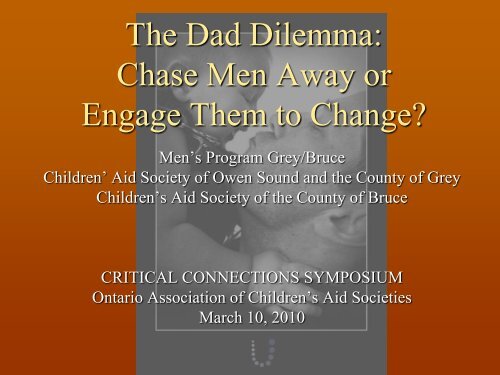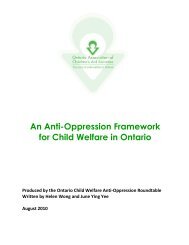The Dad Dilemma: Chase Men Away or Engage Them to Change?
The Dad Dilemma: Chase Men Away or Engage Them to Change?
The Dad Dilemma: Chase Men Away or Engage Them to Change?
- No tags were found...
Create successful ePaper yourself
Turn your PDF publications into a flip-book with our unique Google optimized e-Paper software.
<strong>The</strong> <strong>Dad</strong> <strong>Dilemma</strong>:<strong>Chase</strong> <strong>Men</strong> <strong>Away</strong> <strong>or</strong><strong>Engage</strong> <strong>The</strong>m <strong>to</strong> <strong>Change</strong>?<strong>Men</strong>’s Program Grey/BruceChildren’ Aid Society of Owen Sound and the County of GreyChildren’s Aid Society of the County of BruceCRITICAL CONNECTIONS SYMPOSIUMOntario Association of Children’s Aid SocietiesMarch 10, 2010
My <strong>Dad</strong>’s GroupA Parenting Program f<strong>or</strong> High RiskStruggling FathersMy <strong>Dad</strong>’s Group Program provides a supp<strong>or</strong>tive environment so men maylearn, accept and embrace their roles and responsibilities as fathers inenhancing the well-being of their children.
Presenters:• Cathy Cartwright, Children’s Aid Society of OwenSound and the County of Grey, Child ProtectionW<strong>or</strong>ker• Sue Sahler, Children’s Aid Society of the County ofBruce, Family Resource W<strong>or</strong>ker• Joachim Ostertag, <strong>Men</strong>’s Program (Grey/Bruce)Manager
<strong>The</strong> Child Welfare Context• Hist<strong>or</strong>ically, child welfare staff focussed mostly on services <strong>to</strong>mothers• <strong>The</strong>re is little infra structure within child welfare <strong>to</strong> servefathers and w<strong>or</strong>kers often have limited resources <strong>to</strong> w<strong>or</strong>k withabusive men• Fathers often are ign<strong>or</strong>ed <strong>or</strong> required <strong>to</strong> remove themselvesfrom the family f<strong>or</strong> the safety of the children: they feel chasedaway• In reality many of these men return <strong>to</strong> their partners <strong>or</strong> repartnerand the safety problem is then re-located <strong>to</strong> a newfamily
<strong>The</strong> Partner Assault Response (PAR) Context• <strong>The</strong> <strong>Men</strong>’s Program (Grey Bruce) has provided <strong>Men</strong>’s Groups(Partner Assault Program PAR) <strong>to</strong> men who abused theirpartners since 1989• Almost since it’s beginnings, the <strong>Men</strong>’s Program was part ofthe Children’s Aid Society of the County of Grey and the Cityof Owen Sound and collab<strong>or</strong>ated actively with other violenceagainst women sect<strong>or</strong>s• <strong>The</strong> <strong>Men</strong>’s Group Program was <strong>or</strong>iginally based on the Duluthmodel which has been modified since then
<strong>Men</strong>’s Groups (PAR) always followed a feministanalysis:• Recognizing and addressing woman abuse as power andcontrol tactics within a patriarchal societal context• Emphasising men’s accountability f<strong>or</strong> personal beliefs andactions• Challenging societal beliefs and attitudes about men andwomen and foster critical thinking in these areas• W<strong>or</strong>king with men <strong>to</strong>wards personal goals of treating womenand children with respect
<strong>The</strong> Reality• <strong>The</strong> <strong>Men</strong>’s Program and our communities recognized thatmany men coming <strong>to</strong> the PAR program are also fathers andcontinue this role• Generally men are getting m<strong>or</strong>e involved as fathers• <strong>Men</strong> who assaulted their children’s mothers are a high risk <strong>to</strong>their children• Many of these fathers are eager <strong>to</strong> develop better parentingskills which is an area the PAR program does not cover• <strong>The</strong> <strong>Men</strong>’s Program and the community observed that fathersdo not attend general parenting programs offered in thecommunity
To provide a supp<strong>or</strong>tive environment somen may learn, accept and embrace theirroles and responsibilities as fathers inenhancing the well-being of their children
My <strong>Dad</strong>’s Group and PAR• My <strong>Dad</strong>’s Group and the <strong>Men</strong>’s Groups (PAR) w<strong>or</strong>k independentlyand complement each other• Fathers who abused their children’s mothers usually attend the<strong>Men</strong>’s Group first bef<strong>or</strong>e entering My <strong>Dad</strong>’s Group <strong>to</strong> address theirissues of woman abuse• <strong>Men</strong> are expected <strong>to</strong> show progress re respecting their partners• Mothers need <strong>to</strong> be safe• While the PAR program emphasizes accountability, attitude andbehaviour changes, My <strong>Dad</strong>’s Group focuses on supp<strong>or</strong>ting fathersin developing a child centred parenting approach
<strong>The</strong>ref<strong>or</strong>e…We believe that in <strong>or</strong>der f<strong>or</strong> fathers <strong>to</strong> engage in change, we must:• Encourage, excite and empower fathers in their roles as they learn <strong>to</strong>take ownership f<strong>or</strong> their choices as fathers.• Help fathers understand how their roles as father, man and malepartner impact on their children and families …• Focus on the health and nurturance of children and their fathers byhelping them build healthy father child relationships• Be a place f<strong>or</strong> all fathers <strong>to</strong> feel safe and comf<strong>or</strong>table …• Help men understand the social and cultural construction of oursociety including gender issues and gender stereotypes and how theyimpact on fathers, mothers and children and how <strong>to</strong> deal with theseissues constructively
Curriculum Components• My <strong>Dad</strong>’s Group Curriculum has two componentsthat use a closed group f<strong>or</strong>mat• Component One: My <strong>Dad</strong>’s Group f<strong>or</strong> Fathers• One Orientation session.• Ten (10) My <strong>Dad</strong>’s Group sessions.• Each group is 2 ½ hours long and begins with a Dinner• One Family Breakfast (around session 4 -5) f<strong>or</strong> groupparticipants, their children and partners that usuallytakes place on Saturday m<strong>or</strong>ning. Family pictures aretaken f<strong>or</strong> the families.• Groups are co-lead by a male and a female group leader
Curriculum Components cont.• Component Two: Co-Parenting as a Team Group• A three (3) session Co Parenting as a Team Group f<strong>or</strong> fathersand their partners <strong>or</strong> ex partners who wish <strong>to</strong> w<strong>or</strong>k oneffective co-parenting.• Mothers need <strong>to</strong> be inf<strong>or</strong>med that their attendance of theFamily Breakfast and Co-Parenting Sessions are <strong>to</strong>tallyvoluntary and have no impact on cus<strong>to</strong>dy matters.<strong>The</strong> complete curriculum takes a <strong>to</strong>tal of fourteen (14) weeks <strong>to</strong>complete and can be offered three times a year
Partner ContactUsually female Group facilitat<strong>or</strong>s contact the partners of meninvolved in the My <strong>Dad</strong>’s Group several times over the courseof the group:• <strong>to</strong> inf<strong>or</strong>m the partner about the man’s plans <strong>to</strong> attend the group• <strong>to</strong> provide her with inf<strong>or</strong>mation about the group process, goalsand expectations• <strong>to</strong> talk with her about any safety issues and/<strong>or</strong> safety planningthat is necessary
Partner Contact cont.• <strong>to</strong> provide inf<strong>or</strong>mation about the Co-Parenting as a Team group• <strong>to</strong> discuss her inf<strong>or</strong>mation and supp<strong>or</strong>t needs, and <strong>to</strong> answer anyquestions, <strong>or</strong> discuss any concerns she has• <strong>to</strong> discuss her involvement and the involvement of the children in theFamily Breakfast
Service Delivery Model• <strong>The</strong> Curriculum is designed acc<strong>or</strong>ding <strong>to</strong> amodel with four stages which reflectFather’s individual learning process as wellas the group process
4. Consolidation1. Attachmentand <strong>Engage</strong>ment3.Challenging the Pastand Creating the Future2. Learning andDevelopment
Fathers’ Evaluations (post group)What did you learn from My <strong>Dad</strong>’s Group?• I put myself in their shoes• I don’t like being yelled at and I’m sure they don’t either• Different aspects of being a father and that my way is not the onlyway• …<strong>to</strong> listen <strong>to</strong> my kids’ needs. All problems don’t have the sameanswers• …talking <strong>to</strong> my wife first on dealing with the kids• A better understanding of my anger and how it affects others
Mothers’ Evaluations (post group)What was the most valuable part f<strong>or</strong> you in the co-parentinggroup?• Learn <strong>to</strong> communicate with my partner• That dads can do just as much as mothers, let children havechoices• W<strong>or</strong>king <strong>to</strong>gether as partners• …it was good <strong>to</strong> see him involved and willing <strong>to</strong> learn
Mothers’ Evaluations (post group)What if any changes do you see your partner making in his role asa father and parenting partner?• He talks m<strong>or</strong>e <strong>to</strong> the kids than he ever did• I think he will be able <strong>to</strong> understand our child’s stages andattitudes• He’s not yelling and we are talking <strong>to</strong>gether as a couple• We are m<strong>or</strong>e supp<strong>or</strong>tive of each other• He is not getting overwhelmed and controls his anger
CAS W<strong>or</strong>kers’ Evaluation• 2 of 3 dads <strong>to</strong>ok ownership re how their behaviouraffected their children• <strong>Dad</strong>s’ capacity <strong>to</strong> understand their children’s needsis reflected in their ability <strong>to</strong> articulate specificissues• Family relationships improved. Fathers’ Interactionswith partners and children became much m<strong>or</strong>epositive• Fathers’ ability <strong>to</strong> actively problem solve did greatlyincrease• Ability <strong>to</strong> case plan with both parents has improved
DemographicsSome Stats• Total Population Grey-Bruce Counties : 157 000• Density: About 19 / km 2 (T<strong>or</strong>on<strong>to</strong>: 3972 / km 2 )My <strong>Dad</strong>’s Group• Total referrals / year: Approximately 75• Referral Source: CAS – 65%, Probation – 25%, Self –45%• <strong>Men</strong> who attend My <strong>Dad</strong>’s Group after PAR: 45%• Participation in Co-Parenting Sessions: 40%• Total Children Served, 2008: 135• Children Served (Grey and Bruce CAS) 2008: 97
Stats (cont)High Risk (a hist<strong>or</strong>y of abuse <strong>to</strong>wards children and/<strong>or</strong> partner) 72.1 %Struggling Fathers (having a special needs children <strong>or</strong> havinglimited access <strong>to</strong> their children because of court <strong>or</strong>ders) 19.4 %Not being a High Risk <strong>or</strong> Struggling Father 8.5 %Other issues (identified by fathers) Alcohol <strong>or</strong> Drugs 21.7 % <strong>Men</strong>tal Health Issue 25.6 % Anger management problems with their children 57.4 %
My <strong>Dad</strong>’s GroupA Parenting Program f<strong>or</strong> High RiskStruggling FathersMy <strong>Dad</strong>’s Group Program provides a supp<strong>or</strong>tive environment so men maylearn, accept and embrace their roles and responsibilities as fathers inenhancing the well-being of their children.
















